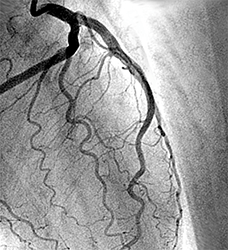
What is a Cardiac Angiogram?
Blood transports life-sustaining oxygen and other essential nutrients to all parts of the body. Blood flows through tiny vessels called arteries and veins. Defects in these blood vessels can interrupt the flow of blood.An angiogram is an imaging test that uses a special dye and X-ray images to take pictures of blood flow in arteries and veins. This test is used to diagnose abnormalities such as narrowing, enlargement, malformed and blocked arteries or veins in various parts of your body.
Pre-procedural preparation
Before an angiogram, inform your doctor if you are pregnant, breast-feeding, asthmatic, have bleeding problems, or any allergies to iodine dye, bee stings or shellfish. Your doctor will ask you about the medicines you are taking and review your history. Your doctor may order certain blood tests to determine your blood’s clotting ability and kidney functions. You will be asked to stop medicines that prevent clotting. Your doctor will advise you to avoid drinking for 4 to 8 hours before the procedure. You will be asked to empty your bladder before the test begins.
Procedure of Angiogram
The following steps are involved in performing an angiogram:
- You will lie on your back on an X-ray table. Your doctor will insert an intravenous line in the vein of your arm to provide the required medicines and fluids.
- A pulse oximeter will be placed on your finger or ear to measure the levels of oxygen in your blood. Electrodes will be placed on your arms, chest or legs to record your heart rhythm and heart rate.
- The groin or region above the elbow where the catheter is to be inserted will be cleaned, shaved and numbed with a local anaesthetic.
- Your doctor will insert a guide wire through a needle into the blood vessel, after which the needle is removed. The catheter will then be inserted into the blood vessel over the guide wire and advanced to the area to be studied. A fluoroscope (real time X-ray) will be used to monitor the path of the catheter in the blood vessel.
- The iodine dye will be injected through the catheter and many X-ray images will be taken to check the flow of the dye through the blood vessel. You will be asked to hold your breath for a few seconds. After the angiogram, the catheter is removed, and pressure is applied on the needle site to help stop bleeding. The site is then covered with a bandage. The entire procedure takes 1 to 3 hours to complete depending on whether other procedures such as angioplasty are performed.
Post-procedural Care for Angiogram
Following the procedure, bed rest is recommended for several hours. Ice packs can be used to relieve pain and swelling over the needle site. You will be prescribed medication to relieve any discomfort. If the catheter was inserted in your arm, avoid blood tests and blood pressure measurements for several days after the procedure. If the catheter was inserted in the groin area, the leg should be kept straight for about 6 hours. You will be asked to consume plenty of fluids to prevent dehydration and to flush the dye out of the body. Avoid strenuous exercises and activities such as walking, climbing stairs and driving for at least 12 hours after the procedure.
Risks and complications of Angiogram
As with any procedure, angiogram includes potential risks and complications. These include:
- Bleeding or clotting at the injection site
- Blood vessel damage
- Risk of heart attack
- Occasionally, kidney damage or severe allergic reaction to the dye
